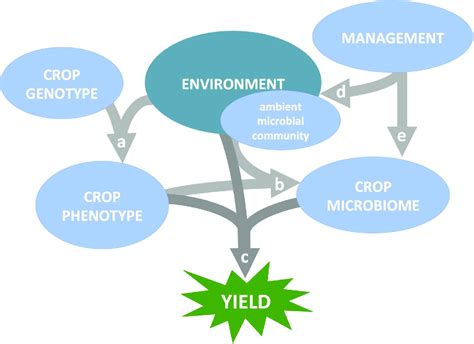Introduction
Crop yield and quality are intricately influenced by a symphony of genetic and environmental factors, with genotype by environment interactions (GEIs) playing a pivotal role in shaping crop performance across diverse agro-climatic zones. Understanding the intricate interplay between crop genotype and environmental variables is paramount for optimizing crop productivity and resilience in the face of changing climate patterns.

Environmental Variables: A Spectrum of Influences
Environmental variables encompass a vast spectrum of factors that can alter crop growth and development. These include:
- Temperature: Temperature fluctuations can influence crop phenology, biomass accumulation, and yield.
- Water availability: Drought stress or excessive precipitation can profoundly impact water uptake, nutrient transport, and yield.
- Soil fertility: Soil nutrient content, pH, and organic matter levels affect nutrient availability and root growth.
- Light intensity and duration: Photosynthesis, canopy architecture, and yield are influenced by light availability and duration.
Genotype by Environment Interactions: Unraveling the Complexities
GEIs refer to the differential response of different crop genotypes to varying environmental conditions. This complexity arises from the unique genetic makeup of each genotype and its interaction with the environment.
For instance, heat-tolerant genotypes may exhibit enhanced yield under high temperatures, while drought-tolerant genotypes perform better in water-limiting conditions. Understanding these interactions enables breeders to select genotypes that are well-suited to specific environments.
Measuring GEIs: A Quantitative Approach
Quantifying GEIs is crucial for estimating crop performance under different environmental conditions. Several statistical methods are employed to measure GEIs, including:
- Linear regression models: These models estimate the relationship between genotype performance and environmental variables.
- Genotype main effects and genotype x environment interaction models (GGE biplots): GGE biplots provide a graphical representation of GEIs, allowing for the identification of genotypes with stable performance across environments.
- Additive main effects and multiplicative interaction models (AMMI): AMMI models decompose GEIs into additive and multiplicative components, facilitating the interpretation of complex interactions.
Practical Applications: Harnessing GEI Knowledge
Unveiling GEI patterns offers practical applications in crop breeding and management:
- Cultivar selection: Breeders can select genotypes that exhibit desirable performance under specific environmental conditions.
- Crop management: Farmers can adjust crop management practices based on GEI predictions to optimize yield and quality.
- Climate change adaptation: Understanding GEIs helps predict crop performance under changing climate patterns and develop adaptation strategies.
- Resource allocation: GEI information can guide resource allocation decisions, such as fertilizer application or irrigation scheduling.
Tables
Table 1: Examples of Environmental Variables and Their Effects on Crop Growth
| Environmental Variable | Effect on Crop Growth |
|---|---|
| Temperature | Influences phenology, biomass accumulation, yield |
| Water availability | Affects water uptake, nutrient transport, yield |
| Soil fertility | Impacts nutrient availability, root growth |
| Light intensity and duration | Influences photosynthesis, canopy architecture, yield |
Table 2: Statistical Methods for Measuring Genotype by Environment Interactions
| Statistical Method | Application |
|---|---|
| Linear regression models | Estimates the relationship between genotype performance and environmental variables |
| GGE biplots | Graphical representation of GEIs, identifies stable genotypes |
| AMMI models | Decomposes GEIs into additive and multiplicative components |
Table 3: Practical Applications of Genotype by Environment Interactions
| Application | Benefit |
|---|---|
| Cultivar selection | Selects genotypes suited to specific environments |
| Crop management | Optimizes yield and quality based on GEI predictions |
| Climate change adaptation | Predicts crop performance under changing climate patterns |
| Resource allocation | Guides resource allocation decisions (e.g., fertilizer application) |
Table 4: Economic Impact of Genotype by Environment Interactions
| Crop | Yield Gain (%) | Economic Impact (USD Billion) |
|---|---|---|
| Maize | 5-10 | 10-20 |
| Wheat | 3-5 | 5-10 |
| Soybean | 2-4 | 2-5 |
Conclusion
Environmental variables exert a profound influence on crop genotype by environment interactions, shaping crop performance across diverse agro-climatic zones. Understanding these interactions is essential for optimizing crop productivity, resilience, and resource allocation.
By leveraging statistical methods and practical applications, researchers, breeders, and farmers can harness GEI knowledge to enhance crop production and ensure food security in the face of increasing environmental challenges.
